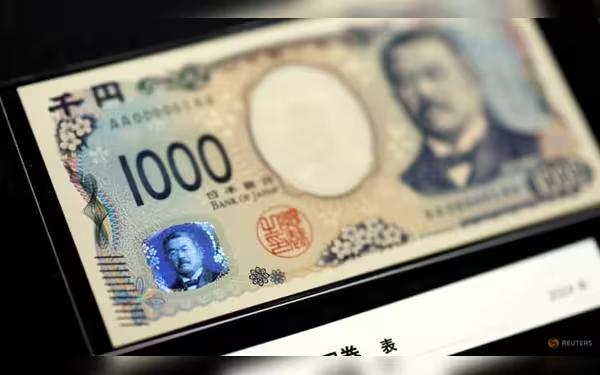Thursday, November 7, 2024 01:09 PM
Yen Faces Pressure as Dollar Surges Past 152 Mark
- Yen drops to 152.82 against the dollar.
- Political uncertainty in Japan raises concerns.
- U.S. yield curve influences currency fluctuations.
 Image Credits: channelnewsasia
Image Credits: channelnewsasiaThe Japanese yen faces pressure as the dollar surpasses 152, influenced by U.S. yields and political uncertainty in Japan.
The currency markets are currently witnessing significant fluctuations, particularly with the Japanese yen coming under pressure against the U.S. dollar. On Wednesday, the dollar surged past the 152 yen mark for the first time since late July, reaching a notable 152.82 yen. This movement is largely attributed to the prevailing expectations that the Federal Reserve will not hastily cut interest rates, alongside investor sentiments regarding a potential election victory for former President Donald Trump.
As the dollar continues to strengthen, the euro has also felt the impact, dropping to its lowest level in over three months. The euro traded at 164.7 yen, marking a 0.95 percent increase against the yen, while the British pound rose by 1.06 percent to 198.19 yen. Analysts suggest that the yen's sensitivity to U.S. yield movements is a key factor driving this trend. Roberto Cobo, an expert in the field, noted that the upcoming general election in Japan, scheduled for October 27, adds another layer of uncertainty. Recent polls indicate that the ruling Liberal Democratic Party may lose its majority, raising concerns about potential political instability.
In the backdrop of these developments, the U.S. yield curve remains a significant driver for the Japanese yen. The yield on the benchmark 10-year U.S. government bond reached 4.24 percent, its highest since late July, as markets adjusted their expectations regarding the Federal Reserve's rate cuts. A month ago, investors anticipated a 25 basis point cut, but now there is a 91 percent chance of a more moderate quarter-basis-point cut in November.
The dollar's strength is further bolstered by the possibility of Trump winning the upcoming presidential election, which has led to increased confidence in the U.S. currency. Meanwhile, the euro has struggled against the dollar, trading at $1.07770, its lowest since July 3. This decline is compounded by recent weak economic data from Europe and shifting market expectations for more rate cuts from the European Central Bank (ECB).
As the ECB deliberates on whether to lower interest rates to stimulate the economy, the euro has underperformed against the British pound, which has remained relatively stable. The pound was flat at $1.29805, hovering around a two-month low. The dollar's influence extends beyond the yen and euro, also reaching a two-month high against the Swiss franc and showing slight gains against the Canadian dollar ahead of a Bank of Canada meeting.
The current dynamics in the currency markets highlight the intricate relationship between political events, economic data, and central bank policies. As investors navigate these fluctuations, it is essential to stay informed about the potential implications of upcoming elections and economic reports. Understanding these factors can provide valuable insights into future market movements and help individuals make informed financial decisions.













